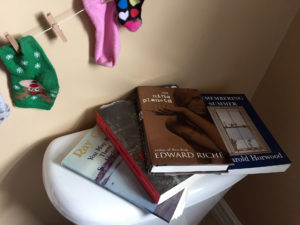My brother Mark has suggested that our guides provide a personal reading list of Newfoundland books we can add to their profile page on the McCarthy’s Party Tours website. This is part of our plan to familiarize our guests with their potential hosts and perhaps afford them with an opportunity to better prepare for their adventure in Newfoundland. When I started to peruse my list I realized that the compilation of material was so bizarre it probably required some explanation and so I decided to present mine in the form of a blog.
In my opinion there is one single book everyone should embrace before visiting Newfoundland, and that is Kevin Major’s history of Newfoundland – ‘As Near to Heaven by Sea’. At first glance, this sizable volume might appear a little daunting, but it follows an interesting chronology that reads especially well; a basic presentation of facts which are sprinkled with many personal anecdotes and innuendos that hint at the authors interests, criticisms, and love for his homeland. Major doesn’t play to the classic dramatization of events or relationships that seem to characterize most Newfoundlander’s misinterpretation of our history. He is obviously a very proud Newfoundlander.
As you have probably guessed, I tend to spend most of my time in the nonfiction section of the Newfoundland book store so my reading trends away from the mainstream. I read John Millais’, ‘Newfoundland and its Untrodden Ways’ for an interesting perspective on Newfoundland’s unexplored wilderness as described by a late 20th century naturalist, artist, adventurer, hunter and writer. I enjoyed Newfoundland’s aviation history and the missed economic opportunity Rob Stone presents in his new book, ‘A Gentlemen’s Agreement’. I’m still battling my way through Judge Prowse’s ‘History of Newfoundland’, a most comprehensive study of the island when we were still a country with great hopes and dreams for the 20th century and all it might offer. And I cherished every moment I spent with ‘White Tie and Decorations’, a compilation of letters written by Sir John and Lady Hope Simpson to their family in England while they were stationed in Newfoundland during our period of Commission Government. For despite the impoverishment they witnessed during the country’s state of insolvency (1934 – 36), they still found much beauty in a broken country and they make this known in every note of correspondence. They had great hopes for the island’s future and its resilient peoples.
Newfoundland boasts many talented, award winning, fictional authors, and I’ve really enjoyed all of the time I spent with Michael Crummy, Donna Morrissey and Wayne Johnston. My favorite Newfoundland author of fiction might come as a surprise, but I feel that Harold Horwood has a great grasp on even the slightest nuance expressed in every culture found in the province. His appreciation, explanation and interpretation of the Inuit people in ‘White Eskimo’ should be used as a model for today’s Department of Indian Affairs. And his measure of the merchant in ‘Tomorrow will be Sunday’ supports the argument I have often made regarding the merchant’s real role in Newfoundland communities; where most shared the rewards equitably, despite the fact they assumed all the financial risk. (How else might you explain the presence of over 1000 heritage homes in the town of Bonavista?)
Perhaps my most influential read this year was ‘The Diaries of James Young’. Young was a 17th century surgeon who started his career in the British Navy. Though he only mentions Newfoundland twice, his records are made without sensation, simply stated as facts. Facts which changed many of my thoughts, and altered much of the way I look at Newfoundland’s history. James Young made me realize that sailing voyages, even in times of war, were far more common place and much safer than I would have ever imagined – it was after all, the most advanced and effective means of transport in the 1600’s.
Thus I no longer think of Newfoundland as a remote and distant island, but the most important point on a transportation route that triangulated between North America, the Caribbean, and Europe (Suppose we did have pirates lurking about with that kind of booty afloat). I know that life may have been hard in Newfoundland, but as Young reminds us, it was far more pleasant than that which could be found anywhere else on the planet during the 117th century.
A moderate climate that couldn’t kill you, clean water, fresh air, tremendous wealth, and plenty of means to find not only food and sustenance, but also many luxuries including silverware, beautiful ceramics and decorative glass. We even had the first Medicare system in North America – and thus the reason for Young’s time in Newfoundland when he hired out for a flat fee to provide medical attention to plantation and migratory fisherman operating on the ‘Southern Shore’ between Bay Bulls and Fermeuse.
Of course, I also enjoy a good laugh from time to time and Ted Russel’s ‘Tales of Pigeon Inlet’ provides many solid chuckles and the finest example of Newfoundlander’s wit.
I love this place with a passion and I look forward to sharing my home and our culture with you this summer.
All my best,
Andrew McCarthy



